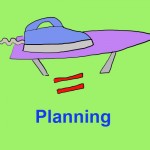
This week I have just completed sessions within university on planning for mathematics within primary schools. However, the process of producing a weekly or session plan is to me only one part of the process. There exists a more hidden part of planning, what I call ‘invisible planning’!
In order to give you an insight into this process, I thought I would reveal how I plan up to the production of the weekly plan. These points are quite generic and I use a similar process for the other curriculum subjects as well as for planning my sessions within higher education.
- In the beginning… – Planning for me starts quite a while before the actual writing of the plan. Initially I have to get all the information together that I need to plan with. This starts with where the students are at. Do I have to repeat or consolidate learning? Do I have to tackle new learning? These objectives usually come from my long or medium term planning, supported with my previous assessment on the subject I am going to teach. Once I have this firmly in my mind, then I can progress to the next step.
- Anything new… – Next I have a look at everything I have saved and tagged with teaching approaches in my Pocket. This allows me to have a look at something new to use within the session/lesson. This might be a new piece of technology or just a way of learning which I thought I might use. It is important to note here, that the information in my Pocket is always generic. I am not looking at activities here, I am looking at approaches. Remember you need to avoid starting from the activity and going to the learning, it should always start from the learning.
- Time to think… – I always allow time within my timetable for the day to think. This usually is a multi tasking event/task like walking to work or doing the ironing. This is the time that I mull over the ideas which my brain hopefully generates about the session, linking the learning and new approaches – or sometimes the regular approaches – together. The brain is very good at coming up with new ideas and approaches -(some people might call this creativity)- but you have to give it time. I once read (I must start sources these) that more ideas will occur the longer you think about something, so do not necessarily take the first idea you come up with, unless it’s fantastic and you are inspired, in which case you are done with this stage. At this point it is worth saying that you need to create some way of recording your ideas. There is nothing worse than coming up with a brilliant idea and then forgetting it before you actually have recorded it – this appears to be happening more and more as I get older!
- Record everything… – By the time I have got to this part of the planning, I am ready to create my lesson/session plan. However, I still put one more step into the process. I actually create a ‘map’ of the lesson/session. This might be a mind map (literally in my mind) or on a piece of paper or app. This allows me to think through the lesson/session and ensure that it ‘flows’ and that the children/student have all the necessary learning they need before moving onto the next stage/part of the lesson. This also allows me to ensure that my activities will actually meet the learning I initially identified.
And so I start to put pen to paper or text to computer. The whole process can last days or minutes depending how stressed I am and how many sessions I am thinking about at the same time. Sometimes things don’t happen and nothing new comes to life or I just don’t have the time to think of new ideas – although I can usually complete the cycle. What I wanted to identify and highlight is that planning is not just writing things down on a piece of paper. It is a process which requires imagination and time to complete successfully. Hopefully you have read something that has been helpful.
Remember keep up to date with my waffles by subscribing to;
Twitter
Blog
YouTube
Facebook
and now on iTunes!
Podcast
Have fun and catch you later!
